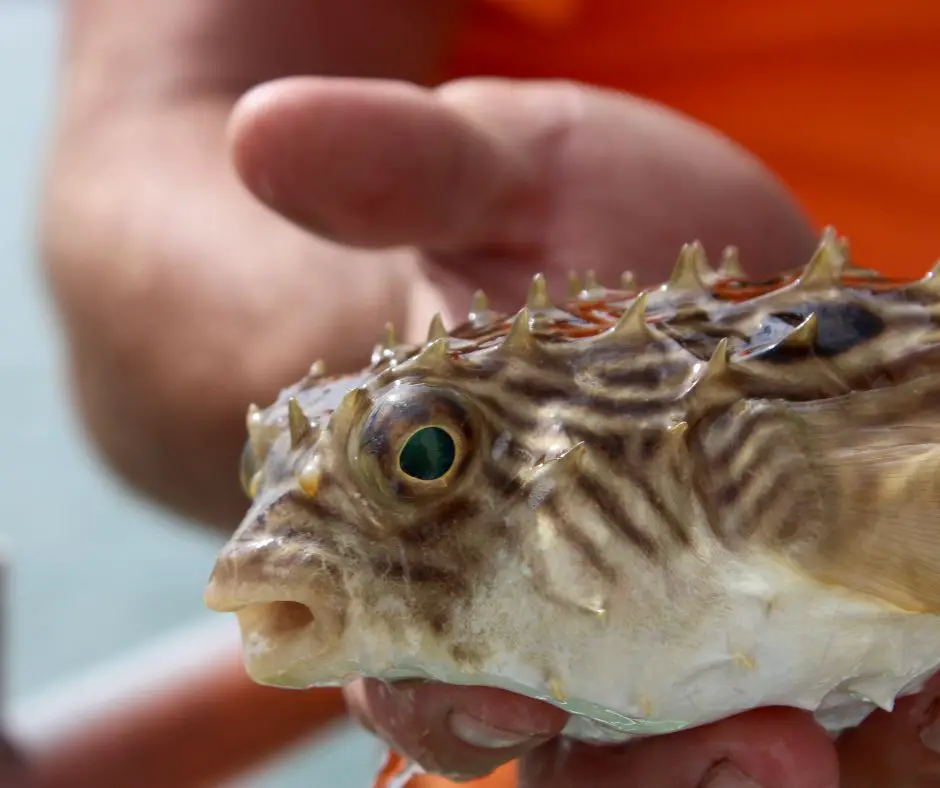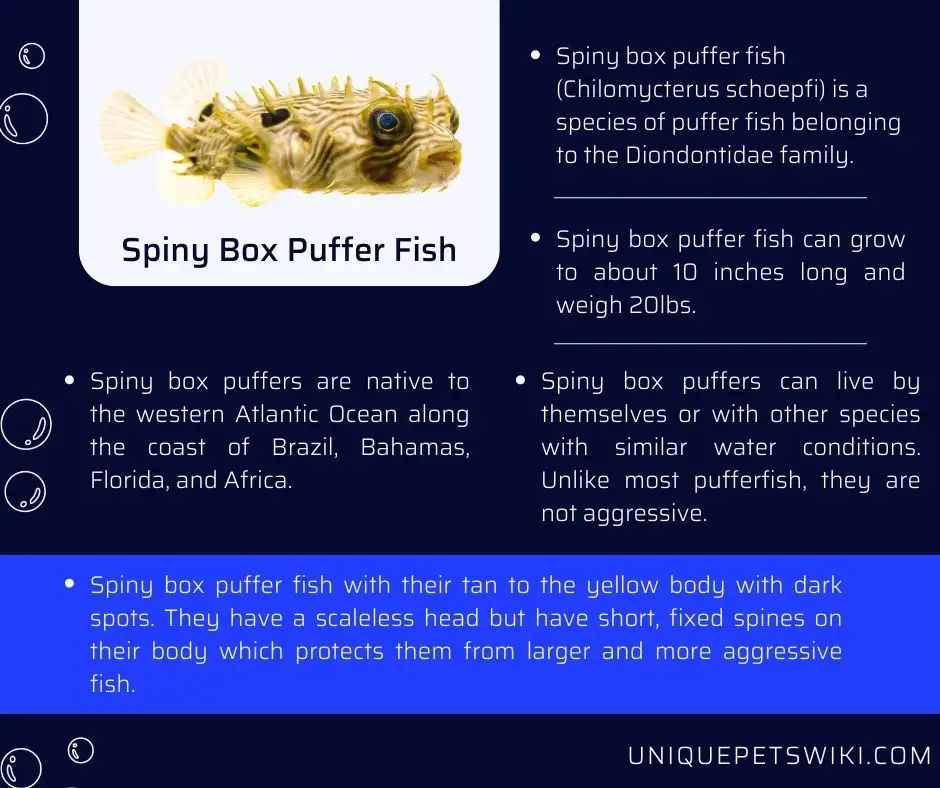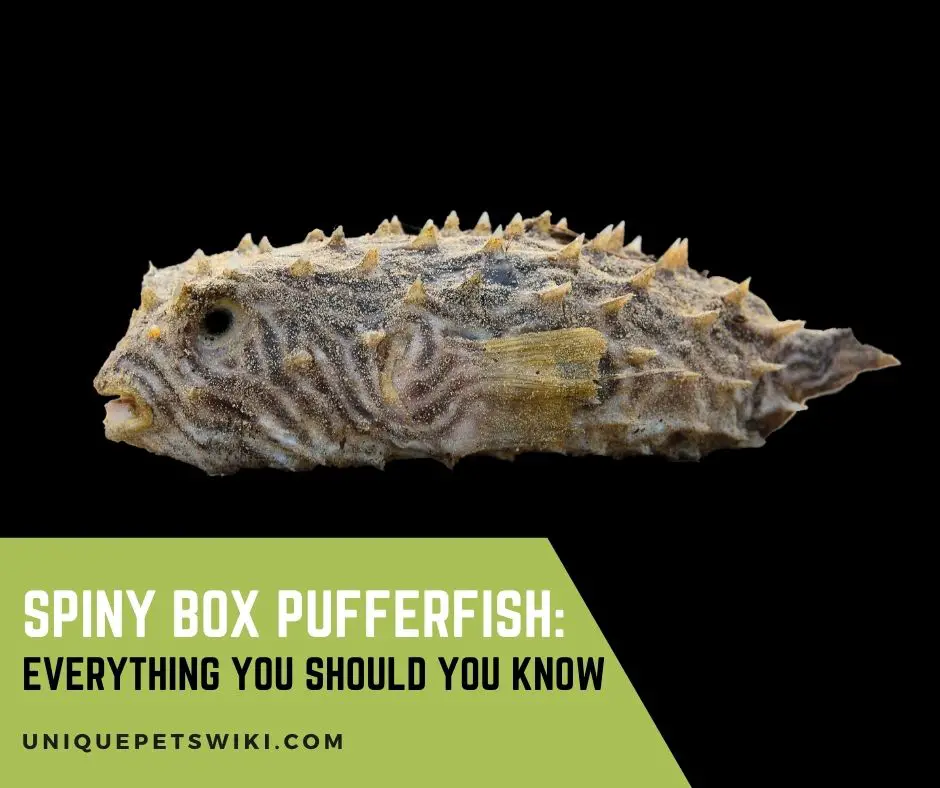One of the things that will surely come to your mind when talking about pufferfish is the image of a bloated fish.
There are varieties of puffer fish species in the world, and experts believe there are over 120 species of pufferfish. Some of them inhabit marine water, while others can be found in freshwater.
One of the species of pufferfish is the spiny box puffer fish. Spiny box puffer fishes are also called striped burrfish and are easily identified by their fixed spines that protect them from more aggressive fish.
A fascinating thing about this species is that they are not as aggressive as other puffers.
In this article, we will break down everything you need to know about this stunning puffer, from where they originated to the best way of caring for them.
Contents
Is Spiny Box Puffer Fish a Good Pet Fish?

No, spiny box puffers do not make a good pet fish, even for expert aquarists. This is because they are not that hardy and adjust to captive life very slowly.
They are not suitable for beginner aquarists as they require a lot of room and specialized care to keep them happy and healthy.
Spiny box puffers are also capable of biting humans, which can be quite painful. They also release toxic chemicals in the water, which can affect the life of other aquatic organisms in the tank.
Spiny Box Puffer Fish: Everything You Should You Know
Spiny box puffer fish are oddly shaped and have short and fixed spines that protect them from larger and aggressive fish. Like other pufferfish, spiny box puffers can also inflate their body with water or air when threatened.
It is quite difficult to care for spiny box puffers because they are slow to adjust to captive fare. You can easily get them for about $29-$49, but they are not recommended for novice aquarists.

Spiny Box Puffer Fish Overview
Here is a brief overview of spiny box puffers.
Scientific Name
Spiny box puffer fish (Chilomycterus schoepfi) is a species of puffer fish belonging to the Diondontidae family. They belong to the genus Chilomycterus with six other burrfishes species.
Color And Appearance
You can easily identify spiny box puffer fish with their tan to the yellow body with dark spots. They have a scaleless head but have short, fixed spines on their body which protects them from larger and more aggressive fish.
You can also use their fused beak-like teeth to identify them.
Spiny box puffers do not have swim bladders but can inflate their body with air or water for flipping over rocks or coral heads in their environment.
Origin And Distribution Range
Spiny box puffers are native to the western Atlantic Ocean along the coast of Brazil, Bahamas, Florida, and Africa.
They are commonly found in the ocean between 0-600 feet deep, living on the reefs, seagrass beds, and sandy bottoms of the seafloor. However, you can also see them close to the shore.
Their ability to survive in different habitats means they can thrive in changing environmental conditions. Spiny box puffer fish use their color patterns as camouflage and blend into their surroundings.
Size
Spiny box puffer fish can grow to about 10 inches long and weigh 20lbs.
Behavior
Generally, spiny box puffers can live by themselves or with other species with similar water conditions. Unlike most pufferfish, they are not aggressive.
However, they usually puff their bodies into a spiny ball to fend off predators.
However, they can bite if you try to touch or pick them. Therefore, it is recommended to wear gloves when interacting with them.
Like dolphins, spiny box puffers usually communicate with one another with electronic signals. They also use body language to communicate with each other.
Spiny Box Puffer Fish Care Sheet
Caring for spiny box puffers is quite hard because it takes time before adapting to captive care.
However, you can keep your spiny box puffers in a saltwater aquarium with or without a gravel filter. They also need enough spaces and places where they can hide to help ensure they don’t get stressed.
The size of the tank needed to house a spiny box puffer varies based on whether you are keeping one or a group.
A single spiny box puffer requires at least a 75-gallon aquarium with high water quality to stay healthy and active. However, you will need at least 95 gallons of tank per fish when housing multiple spiny box puffers.
Water parameters
When it comes to water conditions, spiny box puffer fish can thrive in freshwater and saltwater aquariums.
However, they prefer alkaline waters and require a pH between 8-9. The ideal pH for spiny box puffers is between 8.1-8.4.
It is also recommended to add live rocks for natural filtration for the fish and beneficial bacterial growth on the tank surface.
Temperature/Light
The ideal temperature for spiny box puffers is between 77oF-80oF. You can achieve this temperature by using hand-on or under-gravel filters. Spiny box puffers are nocturnal creatures and don’t really need light.
However, if you have light around the tank, you need to dim it at night to help simulate the natural day/night cycle.
Diet
Spiny box puffer fish are omnivorous creatures. In the wild, they feed on both algae and meaty food like shrimp and small fishes. Therefore, you can feed them a diet of flakes or pellets with some seaweed in captivity.
Spiny box requires high-quality algae supplement to their diet to provide them with vitamins and minerals. Some of the common algae you can add are spirulina or chlorella algae species, which are highly nutritious.
When feeding them with pellet food, you need to opt for those with natural color enhancers added to it, like a shrimp extract, to help entice the fish to eat it. You can also feed your puffer with shrimp or pieces of fish.
It is also recommended that you feed them twice a day and even more often if you are housing more than one spiny box puffer in the tank.
Seachem NutriDiet Chlorella Fish Flakes – Natural Probiotic Formula 15g/.5oz
- SUPER FOOD: NutriDiet Chlorella Flakes is a fortified Chlorella flake food for all freshwater and marine fish. Chlorella Algae is considered to be a potential superfood and is included in every NutriDiet Flake formula for its extremely high nutrient content.
- NUTRITIONAL: Consisting of 45% protein, 20% fat, 20% carbohydrate, and 5% fiber, this fortified flake food is overflowing with enzymes, minerals, vitamins, amino acids, and all other nutrients essential to animal life.
- VITAMIN C: Difficult for fish to acquire in a natural diet, the high levels of Vitamin C contained in the NutriDiet Chlorella Flakes help to aid in the formation of connective tissue, scar tissue in wound repair, and bone matrix.
- PROBIOTICS: The probiotics contained in the NutriDiet Chlorella Flakes promote nutrient intake, making these flakes effective in helping the digestive system of fish and inverts.
- FEEDING DIRECTIONS: Feed your ornamental fish as much NutriDiet Chlorella Flakes as they will consume in three minutes of feeding at a rate of 1-3 times daily.
Last update on 2022-12-29 / Affiliate links / Images from Amazon Product Advertising API
How Much Is a Spiny Box Puffer Fish?
You can buy common spiny box puffer fish for $20-$130. The price of a spiny pufferfish usually varies based on the size of the fish, the supplier, health, cost of quarantining and deworming, etc.
For instance, a 1-3 inches spiny box puffer fish costs $40 while an adult will cost more. This is because an adult pufferfish would have become tamed and already used to live in captivity.
Furthermore, deworming of a pufferfish usually costs between $10-$15.
Therefore, you should be ready to pay more for a spiny box puffer fish that has already being quarantined or dewormed.
Wrapping Up
We hope this article provides you with enough information about spiny box puffer fish. You can message us in the comment section below if you have any questions or comments about spiny box puffer fish.

